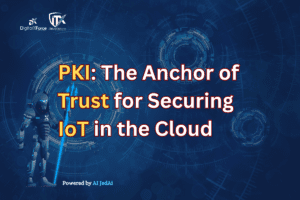
Lalit Ahluwalia is committed to redefining the future of cybersecurity by helping large, medium, and small-scale businesses build digital trust. Here, Lalit highlights the potential of public key infrastructure in IoT security and the opportunities that lay ahead for cloud systems.

As an IT leader in the era of IoT, cloud, and edge computing, you know that connected devices have become ubiquitous. There are now billions of IoT endpoints, from manufacturing equipment to medical devices to smart home systems. But this hyperconnectivity also creates major security challenges. How do you secure vast fleets of IoT devices accessing cloud apps and data?
Look no further than PKI – public key infrastructure. Leveraging PKI for IoT identity and access management provides the scalable cryptographic foundation to secure cloud-connected devices and data across your organization.
In this article, we’ll explore the role of PKI as the anchor of trust for IoT security, how it enables end-to-end protection in the cloud and tips for successful implementation. Let’s dive in!
PKI: Securing Identities and Data in Motion
At its core, PKI uses digital certificates and asymmetric encryption to provide trusted identities and secure communications. PKI certificates bind a cryptographic key pair to an identity – whether a user, device, server, or application. This allows two-way authentication and encrypted data transfer.
Unlike passwords or shared secrets, PKI ensures dynamic secrets through public/private key pairs. The private key proves an identity, while the public key encrypts data. Together, these mechanisms allow safe bi-directional connections between IoT devices, cloud services, and IT infrastructure.
PKI is already widely used in web, VPN, and enterprise security. But for IoT, it offers three crucial advantages:
- Scalable identities – Onboard and manage millions of devices
- Automated, standards-based security – Using mutually authenticated TLS connections
- Encrypted communications – Protecting data in transit and at rest
With IoT, cloud, and 5G disrupting every industry, only a scalable, automated security model like PKI can keep pace.
Anchoring IoT Security from Devices to the Cloud
Here are three ways PKI delivers end-to-end protection for IoT:
- Device identity and access – PKI assigns trusted identities to register devices, enables authentication to cloud services, and authorizes access controls.
- Data encryption – PKI encrypts all communications between devices, gateways, cloud platforms, and IT systems. This secures data in transit and at rest.
- Lifecycle automation – PKI combines with DevOps tools for automated certificate lifecycle management, from enrollment to renewal and revocation.
Taken together, this provides a seamless chain of trust from device to cloud. PKI acts as the anchor, validating identities and encrypting channels.
Key Tips for IoT PKI Success
Based on real-world experience, here are 5 tips to maximize value from PKI for IoT:
- Embed PKI in devices early – Build security in from the start, don’t bolt on later.
- Scale intelligently – Leverage hierarchical CAs and multi-tenant HSMs to optimize performance.
- Integrate with DevOps – Automate certificate lifecycles across tools like Kubernetes.
- Manage proactively – Support revocation and renewal at scale.
- Monitor closely – Get visibility into certificates and crypto health.
Conclusion
As IoT and the cloud collide, PKI delivers the identity layer and cryptographic security to protect data across billions of devices. With strong roots in web security, PKI provides a proven, scalable solution purpose-built for machine identities and automated encryption.
Leverage it early in your IoT journey to securely capitalize on smart devices and ecosystems. PKI allows you to confidently embrace cloud innovation, from edge to core, while keeping data secure.
Related Articles
Cyber Watch – October 27, 2023
Cyber Watch – November 3, 2023
 "Digital trust" cybersecurity solutions enabling automated, real-time risk mitigation are crucial for protecting organizations in today's threat landscape.
"Digital trust" cybersecurity solutions enabling automated, real-time risk mitigation are crucial for protecting organizations in today's threat landscape.